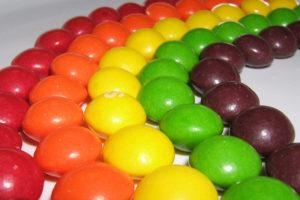 The whole purpose of artificial food coloring is to snag our sense of sight, capture our attention, and lure us in. Maybe it’s a latent survival mechanism – nutritious fruit and veg is brightly colored, too – but technicolor foods appeal to us.
The whole purpose of artificial food coloring is to snag our sense of sight, capture our attention, and lure us in. Maybe it’s a latent survival mechanism – nutritious fruit and veg is brightly colored, too – but technicolor foods appeal to us.
And though most of us don’t think so, food dyes are probably a bigger part of our diets than we realize.
Obvious in many of the foods we deliberately avoid – candies, sugary cereals, soft drinks – dye additives are less obvious in foods that many of us consider healthy. Think cheese. Veggie wraps, Salad dressings. Even oranges, for goodness sake! (Yes, really.)
While the FDA’s Food Advisory Committee convened in 2011 to consider children’s consumption of food dyes and their possible association with hyperactivity, they concluded that the available research didn’t effectively establish a clear link.
Oddly, the committee did have enough concern to develop exposure estimates for each color additive based on age.
And this year, physicians and researchers with expertise in toxicology and behavioral problems in children wrote two letters to the FDA Commissioner urging timely federal action on this public health topic.
Giving a detailed review of the research and first-hand accounts from 2,007 families, they noted that the relationship between food dyes and children’s behavior has become clearer since 2011. In particular:
- One meta-analysis estimated that dietary restriction reduces symptoms in one-third of children with ADHD and that 8% of children with ADHD have symptoms related to food dyes.
- A meta-analysis of six non-drug treatments for ADHD found that excluding artificial food dye from the diet produced the largest effects.
- The European ADHD Guidelines Group compared three meta-analyses and concluded that elimination of food dyes is a potentially valuable treatment.
- Another review rated the evidence for different treatments aimed at reducing ADHD symptoms and ranked exclusion of food dyes and more restricted diets as treatments supported by the second highest level of evidence after medication.
- Other post-2011 reviews suggest that some children improve “significantly” on a dye-free diet.
The letter goes on to say,
Sadly, the general public remains unaware of the risks and children suffer unnecessarily, in part due to FDA’s misleading public communication about the issue. Despite the evidence, one FDA website promises that dyes are not just safe, but “very safe,” and another FDA website and brochure that is published jointly with the food industry’s International Food Information Council, poses the question “do additives cause childhood hyperactivity?” and asserts that “results from studies on this issue either have been inconclusive, inconsistent, or difficult to interpret.
So here in the US, 7 dyes continue to be used widely in our food system – dyes banned in the EU: Yellow #5 and #6, Blue #1 and #2, Red #3 and #40, and Green #3. Also allowed are Citrus Red #2 (for coloring orange peels) and Orange B (for coloring sausage casings).
If you have concerns about artificial food dye additives, check out CSPI’s comprehensive summary of the issue, which includes a listing of food companies eliminating dyes – a trend we’re very happy to see – and firsthand accounts of how artificial food dyes have affected families across the US.
And if you buy any processed foods, buy from companies who don’t use them or are making the swap to natural coloring agents. Natural colors are derived from things like beets and turmeric.
Remember to say thank you to food companies making the switch. Food manufacturers listen and respond to what they think consumer’s will buy. They don’t just notice trends; they fixate on them.
Right now, if you’re looking to avoid artificial food dyes, there’s only one thing you can do: read every label. But remember: Artificial colors are just one of the many, many synthetic additives in processed foods.
As ever, the best food is food sourced from nature.
Image by Micky**, via Flickr